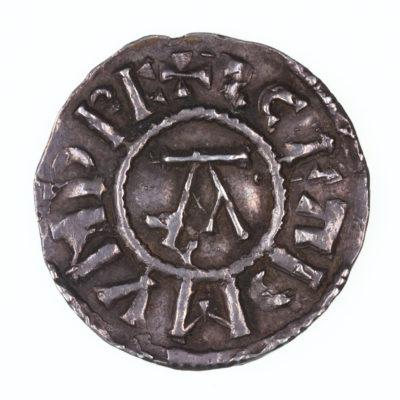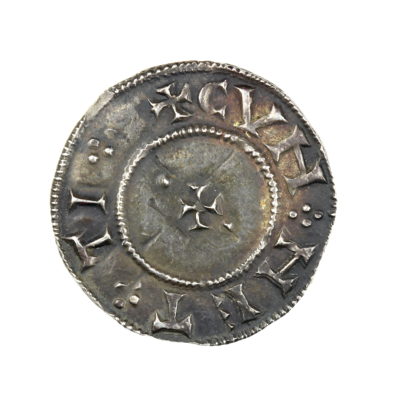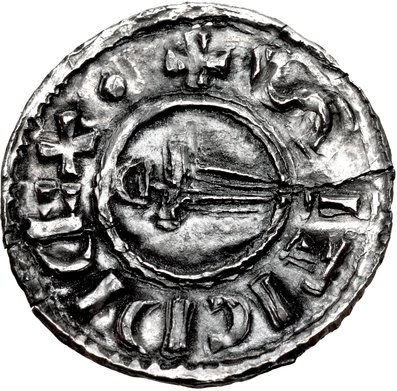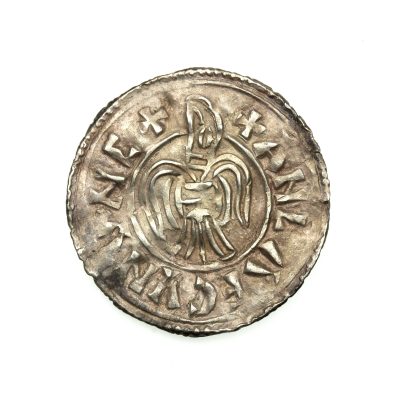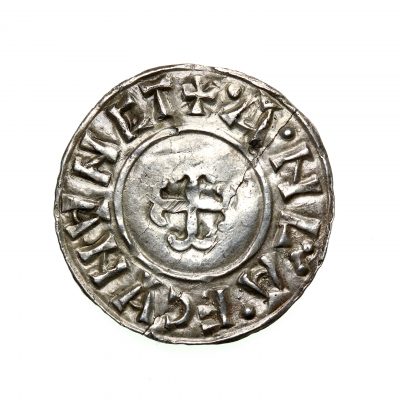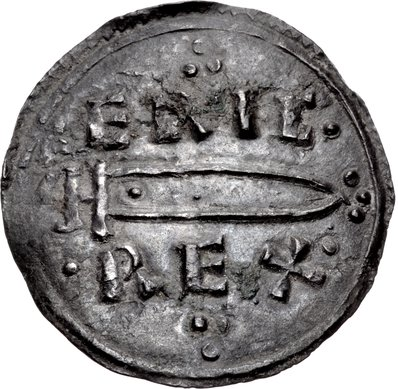Anglo-Viking coinages of the ‘Danelaw’
Introduction
The enactment of the treaty between Alfred and Guthrum in c. 880, while a victory in the sense that the very existence of Wessex had not been snuffed out, was ultimately a compromise. The Viking ‘Great Heathen Army’ had sailed over from Scandinavia seeking new land to settle and treasure to plunder, and in both respects they had succeeded – to a degree. When the dust settled, East Anglia, Mercia and Northumbria were destroyed as political units, leaving Wessex as essentially the only Anglo-Saxon kingdom with an intact administrative and governmental system.
Although Alfred can be seen as partially responsible in his efforts to bind together the disparate Anglo-Saxon kingdoms as one nation, it is interesting to consider what might have happened had the Scandinavians not invaded or been repulsed early on – would ‘England’ even come to exist? If Alfred is the mortar binding together the earliest bricks of the English state, the invading Danes were the means by which its predecessors were demolished, allowing it to be rebuilt from the ground up.
What is ‘Danelaw’?
The term ‘Danelaw’ is not a 9th century one, only appearing in documentary evidence from the early 11th century onwards as reference to a specific geographic area. From our modern perspective, it refers to the areas of Eastern and Northern England which were under Danish law, rather than Anglo-Saxon. These areas, according to the encyclopaedia of Anglo-Saxon England, broadly included the shires (administrative areas) of Bedford, Middlesex, Buckingham, Huntingdon, Hertford, Cambridge, Essex, Suffolk, Norfolk, Northampton, Leicester, Nottingham, Derby, Lincoln and Northumbria – with focus in the last centred on the city of Jorvik (York). The legacy of this self-ruling area is indirectly preserved today in a swathe of Scandinavian place names; settlement names like Grimsby, Lowestoft and Scunthorpe all have Old Norse suffixes as opposed to Anglo-Saxon ones.
Although the initial policy of Alfred and his successors would be to allow the Scandinavians a sort of living space, this changed by the early 10th century. Although the Danelaw would exist broadly from c. 880-954, its various boroughs and shires were re-assimilated by the English kings from the early 10th century onwards – with only Northumbria intermittently remaining under ‘Viking’ control by the 940’s. By 955, the last vestiges of the old Anglo-Saxon kingdoms had finally been swept away, and what we now recognise (broadly) as the nation of England had finally emerged to its full extent.
Along with its independent administration and legal system, coinage was also issued within the Danelaw independent of external interference. In this short introduction to the subject, we will not only discuss the various types of coins encountered by the numismatist, collector and detectorist – but also outline some of the historical framework surrounding them, in what is a notoriously poorly known and rarely taught period of English history.
Coinage of the Danelaw
Imitation as the sincerest form of flattery
The first true ‘Anglo-Viking’ coins can be seen as the imitations of Alfred’s two-line type, struck in East Anglia from approximately 885 onwards. These coins are distinguishable from their official counterparts by the fact that they demonstrate heavily blundered inscriptions. However, some better-quality pieces clearly render the name ‘ÆTHELSTAN’ (or a version thereof) on their obverses, which is clearly a reference to the regnal name taken by Guthrum after his baptism. This imitation did not end with the death of Alfred, as the copying continued into the reign of his son Edward (the Elder) – these being encountered somewhat more frequently.
The two-line imitations are a complex series of coins, a number of which have been brought to light as single metal-detected finds in recent years. One interesting facet of their distribution is that they are rare outside the Danelaw, perhaps suggesting that (at least initially) there was a degree of firm separation between ‘Danish’ and ‘English’ areas.
Saint Edmund’s pennies
Perhaps the most numerous of the Anglo-Viking issues struck in the Danelaw are the so-called ‘St Edmund Memorial’ pennies, copying issues of Edmund – the King of East Anglia who was martyred in 869. These coins were struck in several phases from c. 895-910 by a dizzying array of moneyers, who demonstrate not only indigenous Anglo-Saxon names but also Scandinavian and even continental ones. These attest to a thriving, internationally-reaching polity that was probably somewhat diverse.
It might seem bizarre to think that the sons and grandsons of those who had originally killed Edmund had now moved to striking coins celebrating him as ‘SC EADMUND’ (Saint Edmund) within their own territory. However, perhaps there is a relevant point here to be made concerning the extent to which Christian beliefs had been adopted and the hold which Edmund’s cult held over the local populace. Perhaps the newly-converted Danes, feeling guilty for their ancestors’ martyrdom of Edmund, were trying to make spiritual amends by venerating him on their coins?
Cnut the impostor
Another reasonably commonly encountered Anglo-Viking issue is the so-called ‘Patriarchal Cross’ issue of Cnut – struck in Northumbria from c. 895-910. Although readers might already be familiar with a Scandinavian ‘Cnut’ or ‘Canute’ – he is likely the more famous, later king from the early 11th century. This particular Cnut, who ruled over the Viking territories in Northumbria centred on the city of York, is notable for his striking of a very interesting group of silver pennies, most depicting crosses and accompanied by a variety of reverse inscriptions. Perhaps the most evocative of these reads ‘MIRABILIA FECIT’ (He has done marvellous things), part of the text for Psalm 98. As if the Christian text was not enough, Cnut’s die-cutters added an extra ‘layer’ of symbolism by arranging his name around the coin so as to make the sign of the cross when read.
Swords and Saints
From c. 905 into the 920’s, a series of coins was struck which perhaps consist some of the most recognisable ‘Viking’ coins made in England – immortalised to this day at the Jorvik Centre in York and sold by the hundreds as replicas there. These are the so-called ‘St Peter’ pennies, a complex issue that is perhaps best notable for its large number of die-variants. While the obverses usually display a version of the Latin inscription ‘SANCTUS PETRI’ (St Peter), the reverses vary considerably, depicting images which blend the lines between promoting Christianity and Paganism. One type combines a cross as the central motif on the obverse with a hammer (the symbol of the god Thor) on the reverse, while another places a cross in both central fields but utilises the hammer motif as a spacer in the reverse legend. Yet more variants display images of everyday objects very familiar to the ‘Viking’ inhabitants of York, such as keys and swords – objects also burdened with religious symbolism in both Christian and Pagan narratives. Although the ‘St Peter’ issues of York are the most commonly encountered, there is another (though much rarer) struck at Lincoln – the so-called ‘St Martin’ type. This is perhaps good evidence that coinage was issued outside the core areas of York and East Anglia, if infrequently.
How best to interpret the conflicting symbolism on these coins? One suggestion is that these represent the process of assimilation that took place in England from the early years of the 10th century, whereby pagans were perhaps encouraged to worship their gods in Christian guises – e.g. Thor as the equivalent of St Peter. In a similar fashion (and probably at the same time) many characteristically ‘pagan’ practices began to enter the Christian liturgy – such as the concept of the honeymoon, celebration of Yule, decorating of trees, gift-giving, feasting and drinking at Christmas. Although Hollywood enjoys depicting paganism versus Christianity as an aggressive conflict, in reality it was often a slow process of gradual change that to modern eyes seems surprisingly permissive.
A Numismatic Gap
Following the campaigns (both military and diplomatic) of Æthelstan and Æthelflaed against the boroughs of the Danelaw in the early 10th century, Danish Northumbria was annexed into the newly united Kingdom of England by 927 – the Scandinavian jarls in general choosing to retain their lands and swear fealty as opposed to death or exile. As such, no ‘Anglo-Viking’ coinage was issued between c. 927 and 939, as Æthelstan’s highly politically charged new circumscription-type pennies became currency across the entire realm. These coins title him as ‘REX TOT BRIT’ – King of all Britain (or Britons) – an abundantly clear political statement.
The Return of the Kings
However, following Æthelstan’s death in 939, it was the Norse kings of Dublin who turned their attention to England. In 939, King Anlaf Guthfrithsson invaded Northumbria and re-established the region as an independent political entity, occupying several boroughs in the Midlands as well as York itself. For the next fifteen or so years, Anlaf’s successors would rule intermittently over parts of Northern England, interrupted by episodes where the English kings (invariably only temporarily) regained control. However, the unstable political situation was also contributed to by the Vikings themselves – with a degree of infighting and deposing of kings (with their inevitable return after several years) in evidence. Ultimately, this situation was not tenable in the long term. The last ‘Viking’ ruler of York, King Eric (sometimes known as ‘Bloodaxe’), was killed or expelled in 954 – his followers suppressed by King Eadred of England. Northumbria had been brought permanently back into the English fold.
The return of the Irish-influenced Viking rulers to Northumbria is numismatically visible in the issuing of some very artistically accomplished coins – though plainer pieces do exist which evoke to a greater extent the simplicity of contemporary English designs. Perhaps the most distinctive of these were issued by Anlaf Guthfrithsson and his cousin, Anlaf Sihtricsson – high-quality silver pence depicting a variety of images including ravens, banners and ‘valknut’ designs. One type for the former is particularly interesting because instead of giving his title as ‘REX’ (King) in Latin, it uses the Scandinavian word ‘CUNUNCA’ – a Norse title. Although many have been keen to interpret this and many of the images utilised as pagan ones clearly inferring the rejection of Christianity, the ‘valknut’ (or triquetra) can be seen as symbolic of the Holy Trinity. Similarly, while ravens do appear as companions of Odin, they are also the bird sent out by Noah to find land following the great flood – and also were reportedly sent by God to feed Elijah when he was in hiding as related in the book of Kings in the Old Testament. As with the St Peter coinage, the images on these coins are somewhat religiously ambiguous. However, it is equally possible that they are intended to signify political symbolisms instead.
Hoards and Hoarding
Although Anglo-Viking coins are encountered as single finds, a very large number have also been recovered from hoards. Perhaps the best-known example of this is the Cuerdale Hoard, discovered in Lancashire on the 15th of April 1840 by a group of labourers digging in a riverbank. Buried somewhere around 910, it is one of the biggest ‘Viking’ hoards ever known to have existed. Although a large proportion of the objects, coins and ingots in the hoard ended up in the British Museum, many were spirited away and ended up in private hands, continuing to be sold and re-sold to this day. It is thought the hoard originally contained over 3000 Northumbrian pennies of Cnut and nearly 2000 ‘St Edmunds’. In comparison to this ‘early’ hoard, we also have a number deposited from the 920’s-940’s– some discovered in the last two decades thanks to the popularity of metal detecting. The so-called ‘Vale of York’ hoard contained 617 coins in total (approximately 32 of which were Anglo-Viking issues), in addition to its exquisitely made mid-9th century Carolingian cup and hack-silver (chopped up pieces of silver jewellery). By contrast, the smaller Silverdale hoard contained just 27 coins – a third of which were Anglo-Viking imitations of Alfred the Great two-line pennies and another portion, interestingly, consisted of imported silver Dirhams from the Islamic Abbasid Caliphate. These circulated in the Danelaw during the 10th century, although previously they had been a major element of precious metal hoards in Scandinavia before the minting of coins there became a common practice.

